Science: We All Have Fewer Than Ten Years To Live
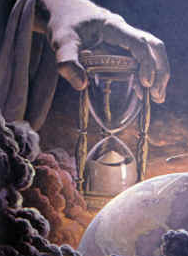
“In many ways, this is it. This is potentially the end. There are no antibiotics in the pipeline that have activity against NDM 1-producing Enterobacteriaceae… We have a bleak window of maybe 10 years, where we are going to have to use the antibiotics we have very wisely, but also grapple with the reality that we have nothing to treat these infections with. It is the first time it has got to this stage with these type of bacteria.” You heard the man! This is it, people! According to Tim Walsh of Cardiff University, it’s time to to tell the people that you love that you love them. Pneumonia and urinary tract infections, that’s how we’re gonna go. Perhaps this will pass like the MRSA scare and, oh right, every other panic of the last twenty years. Or not!
"Mama Grizzlies" Bear Down On Sarah Palin
“Mama grizzlies” who do not believe in the Sarah Palin agenda are attempting to reclaim the term by, uh, dressing up as bears and refudiating (hahah, get it?) the former Alaska governor’s message. It’s good enough, I guess. Plus, you know, Sarah Palin and “bears”? Automatic.
The Web Sure Has Grown Exponentially!
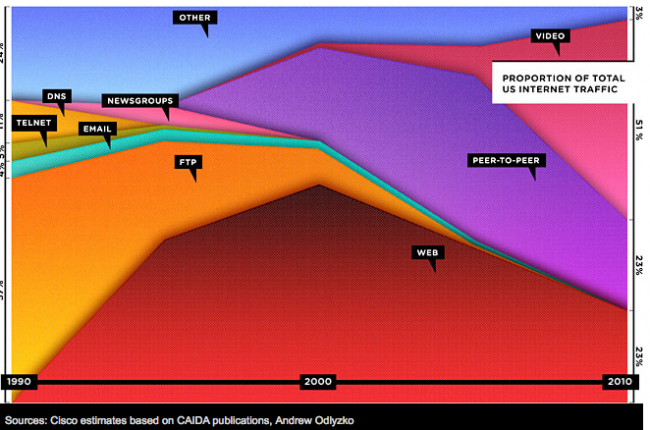
This sure is a neat graph in Wired, to accompany the new theory that “the web is dead” and that the future is apps. The graph explains that, since 1990, usage of the “web” has peaked (at about 50% of Internet use, in 2000) and has since declined, to about 23% of Internet use. There’s another graph that might be of interest when looking at this!
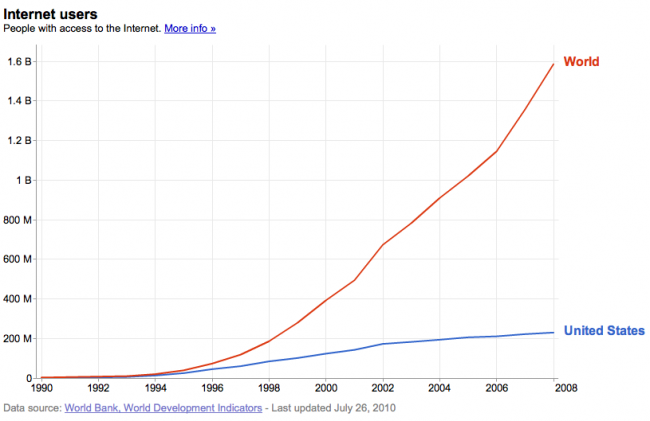
Between 2000 and 2010, Americans with Internet access went from 124 million to 230 million.
(The world at large, by the way, went from 393 million Internet users to 1.5 billion, but let’s keep the focus on America, right Wired? Because we’re so much more interesting and also we buy iPads.)
Rob Beschizza made a related point extremely well. He notes: “According to Cisco, the same source Wired used for its projections, total internet traffic rose then from about 1 exabyte to 7 exabytes between 2005 and 2010.”
So, just in terms of basic Internet-using population in any event, as the “web use” “declined” by half over the last ten years as a percentage of use accorded to Wired, the real world activity presumably, at the same time, “stayed constant due to the doubling of the Internet-user” in the U.S.
Except use of the web blew up far more than that.
There’s a number of other questions I have about these numbers, which are almost the only numbers in the piece, apart from a claim by Morgan Stanley that in five years, more people will use the Internet over mobile devices than PCs.
For instance: doesn’t this chart measure data usage as traffic? Would that perhaps be why the “video” section is so swollen?
Penguins Chase Butterfly
Okay, I know we’re all a little sweaty and agitated and generally irritable because it’s only Tuesday, which, really, how the hell is that possible? Yesterday was like a WEEK. Anyway, chill out, because here is some video of Humboldt penguins chasing a butterfly at the Philadelphia Zoo. They’re just like us! (If we chased butterflies. And were forced to suffer the indignity of living in Philadelphia.)
America Is Country of Foreskin!

Apparently Science is saying that fewer than half of American boys are being circumcised now! This is good news, because, you guys, circumcision is really weird. It’s a super-weird thing to do! And the whole “circumcision as HIV prevention” thing is wacko. You know what prevents HIV? Not putting condom-free penises inside things. And… as always, this is bad news too.
Yes, this is sad news of a bygone era. Now, American guys who go traveling in Europe are going to become less sexually favored. No, seriously!
Once upon a time, dear young people-yes, go on! Gather around! Story time!-an American would go to Europe and be beset by lusty Parisians and Swedes who rarely got a chance to spy a circumcised penis.
And that is how sex tourism was born. No, wait, it wasn’t, that’s something else entirely.
But seriously. Now Americans will show up in London and, I dunno, Gdansk and there’ll be nary a frisson of sexual difference. It’ll just be one more guy with a penis that looks like pretty much every penis because penises, despite their remarkable diversity, really aren’t all that different once you’ve seen a few dozen of them. (And everyone in Europe has, thanks to the socialism.)
Though-to look on the brighter side again-I guess this means Jews will at long last be popular in Europe.
Ladies Are Running for Attorney General of 'CSI'
They’re tough on crime! They’re serious business! They’ve got insanely over-produced campaign ads! It’s Kathleen Rice, who wants to be Attorney General of New York, and Kamala Harris, who wants to be Attorney General of California. As for their new campaign ads, well, this thing rather does look like that thing.
Rice’s is notable also because, with one exception, she is pretty much the only woman to appear in the spot.
Harris’s is notable because she’s getting bothered over her plea deal record.
How can you not vote for them though? It seems like they’re on the TV shows!
We were going to post ads for Rice’s opponent, Eric Schneiderman, but apparently there aren’t any.
Always Think About How It'll Look In The Obituary
I am no moralist. I do my best every day to restrain my urge to judge the actions of others. I remind myself that I am usually ignorant about the needs and desires that motivate them to make the choices they do. I try to stay aware that we all have a different internal compass, and that each of us has occasionally made a choice out of a hard-felt necessity that we might not make otherwise were we in a different position. It is a fact of life of which I attempt to remain constantly cognizant. Still, there is something to be said for thinking deeply and carefully about each pursuit you undertake: You never know which one you’re going to be remembered for.
The Bookmobile: An Excerpt from Ann Finkbeiner's "A Grand and Bold Thing"
by Ann Finkbeiner
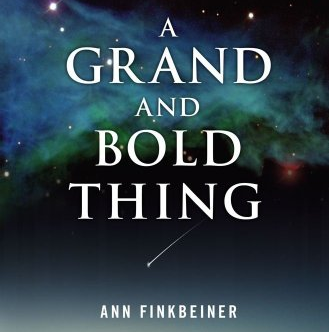
Ann Finkbeiner’s A Grand and Bold Thing: An Extraordinary New Map of the Universe Ushering In A New Era of Discovery documents the founding of the Sloan Digital Sky Survey-and is out today! “Delightful,” says Publisher’s Weekly! “Totally awesome,” says The Awl! The Sloan Digital Sky Survey, begun ten years ago, is mapping 100 million celestial objects-and measuring distance between a million galaxies, giving us the first real map of where we live. And here, an excerpt!
“And what do you want to do with the new telescopes,” I asked Wallace Sargent, who’s a Caltech astronomer. “That’s a boring question,” he said, “and the answer is so boring I won’t answer it. It’s like you’re a Victorian explorer looking for the source of the Nile and when you run across the Pyramids, if you had any sense at all, you’d investigate them. Pardon the expression, but I point the fucking telescope at the sky and see what’s out there.” -interview with Wallace Sargent, 1991
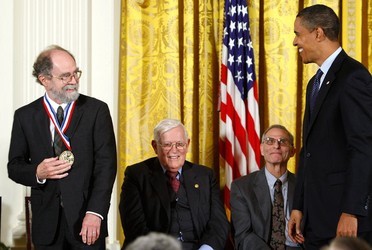
The Hubble Space Telescope’s first image looked like all hell. A month later, late June of 1990, the telescope’s political shepherd, John Bahcall, found out what had gone wrong. He called some interested local astronomers-Jill Knapp, Don Schneider, and particularly Jim Gunn-and since astronomy in Princeton, NJ, usually involves food, he invited them to supper at a Route-206 strip-mall Chinese diner. He told them that NASA was about to announce that the telescope’s perfect mirror had been ground to the perfectly wrong shape. Jim Gunn, who had designed and overseen the construction of the telescope’s principal camera, had also seen the first image, and had thought the problem might be fixed. But no, now Bahcall was telling him no, it was the mirror’s shape, the telescope couldn’t focus, the problem was irrevocable.
Jim and Bahcall did most of the talking. Why hadn’t the astronomers overseeing the NASA contractors caught the mistake? It was a dumb mistake, a beginner’s textbook mistake. Nor did they think that astronauts could change out the mirror on a telescope in orbit nearly 400 miles up. Could they themselves come up with any brilliant ideas? Not at the moment. Certainly any kind of repair would take years, money, and a lot more effort, and they both had already dumped their lives and careers into it. Don Schneider, who had been Jim’s graduate student and was now working with Bahcall, sat there feeling overwhelmed. Jill Knapp, who was married to Jim, mostly listened. Dinners with Bahcall always started early, so they all went home early too….
On July 19, 1990, Jim sat down to write a letter to his community. “My view and point are very simple,” he began. “We are a discipline of technical incompetents, happy to let our or NASA’s engineers build our tools to their desires, by and large, not ours.” He began using capital letters: “It was an ASTRONOMICAL failure; it was an ASTRONOMICAL satellite”-and took a shot at NASA-”and it does not matter a whit that it was probably some fool at PE [Perkin-Elmer, the NASA contractor for the mirror] that caused it and some entirely expected failure of NASA’s criminally infantile QA program that failed to catch it.” Then he took dead aim at the astronomers-”Not that there would have been enough technically competent people in the field to have taken the two G$ and done anything with it.” He concluded: “You may certainly circulate this letter if you wish.”
The letter was electronic and it was printed out and taped to office doors, forwarded and posted to electronic bulletin boards, and talked about in the halls of astronomy departments everywhere. Afterward Jim decided to cut bait; he gave up his privileges to use the telescope. “I was just terribly, terribly disheartened,” he said. He didn’t think it had a chance in hell of being fixed anyway.
NASA, of course, pulled off an ingenious fix, installed by astronauts dangling improbably over the telescope up in space. The Hubble Space Telescope went on to find the two numbers and took gorgeously sharp pictures of everything else: of tiny, distant, golden galaxies and nearby electric blue whirlpools, of radiant towers of starbirth and the opalescent mists of their deaths. An upgraded version of Jim’s camera took some of the best of them.
Jim regretted having cut bait, but only a little. He had just come up with another idea for another camera, even better than Hubble’s with bigger CCDs. He’d put the camera on an unassuming telescope on the ground, turn it on, and let the night sky roll over it. It would make the first-ever three-dimensional, digital sky survey.
The survey would have a million galaxies in it. With a million galaxies, you could make a map showing where galaxies lived, and whether they lived around other galaxies, and whether little chains of galaxies were actually parts of a larger network, and whether that network was actually a network of networks, and how big it all got. With a million galaxies you could make a true census: how galaxies differed, how baby galaxies changed as they grew, and what kinds of galaxies they grew into. With a million galaxies you could watch the universe growing up.
Jim thought a million-galaxy survey was intellectually huge and personally irresistible, the most complete map of the universe ever. It could live in computers and be accessible at all hours to all comers for all time. It could start a new kind of astronomy.
Above: Jim Gunn receiving the National Medal of Science in October, 2009, for “the crucial role those technological marvels played in the creation of the Sloan Digital Sky Survey, which has cataloged 200 million stars, galaxies, and quasars; discovered the most distant known quasars; and probed the epoch of formation of the first stars and galaxies.”
Ann Finkbeiner is a proprietor of The Last Word on Nothing, where they are talking about parasitic wasps today, and the author of A Grand and Bold Thing: An Extraordinary New Map of the Universe Ushering In A New Era of Discovery, which is out today. She runs the graduate program in science writing at Johns Hopkins in The Writing Seminars.
Nepal Zoo Encourages Platonic Rhino Roommates To Take Their Relationship To The Next Level

A zoo in Kathmandu has built a new enclosure for a pair of rhinoceroses specifically designed to encourage mating. Though they’ve lived together for 18 years, the 20-year-old male rhino, Kancha has apparently never done it with the 22-year-old “cougar” rhino, Kanchi. “As far as we can tell, Kancha and Kanchi have never mated,” said zoo manager Sarita Jnawali, of the two of only 435 one-horned rhinos left in Nepal. “Before, we didn’t have the proper facilities for the rhinos to breed, and we hope this new enclosure will help us to increase species numbers.” While the story conjures images of heart-shaped mud pools and troughs of champagne, the new enclosure is basically just bigger, and furnished with separate areas so Kancha and Kanchi can each have their own space. Their previously closer quarters had led to more quarrels than amorousness over the years. Strangely, no one has thought to just chop off Kancha and Kanchi’s horns, grind them into powder, and feed them back to themselves in a medicine capsule. (This would also help keep Kanchi’s skin, which has a tendency to be leathery and plate-armor-like, as beautiful as that of miraculously young-looking 47-year-old supermodel, Elle Macpherson.)
